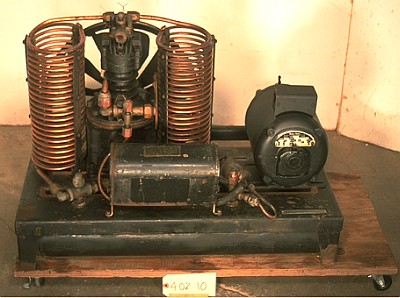Refrigerating and Air Conditioning Condensing Units – Commercial
The oval, copper tube, static air condenser, along with the hefty, solid look of a no-nonsense refrigeration machine seemed to be a winning formula for Frigidaire in the late 1930’s, one that would be reflected and perpetuated through several years of design and production. The higher capacity Model G, with an added oval tube condenser stack, was similarly endowed to the Model S [See #046 and #047]. Also using sulphur dioxide refrigerant, the Model G would be seen in Canadian estate homes, institutions, food stores, diary bars and hospitality applications well into the 1950’s, when the clear preference of the industry and its publics swung heavily to the use of non-noxious refrigerants, leaving this recognised time piece well behind, Frigidaire, 1929.
Technical Significance:
Frigidaire’s commitment to the oval tube, stacked condensing medium in the period was substantial [See Frigidaire manual for the nature and scope of its application]. A simple engineering response, using the materials and know-how of the times, it seemed to perform passably well. The idea of adding additional stacks was a reasonable one, in order to add machine capacity. For a number of reasons the technology would prove to be limited to small capacity, fractional horsepower machines and Frigidaire would need to rethink the form and structure of their condensers, as the inevitable demand for larger and larger machines continued.For Frigidaire an important point of inflection in their design and development curve was at hand. There would be a transition to the more efficient, higher performance, forced air, fin and tube condenser, already in popular use by other manufactures, The oval stacked condenser, a hall mark of Frigidaire’s refrigeration machines was about to disappear, see item #049 and #045.
With the recognised need to move with the times came the commitment to upgrading and the retrofit of existing machines, as a hedge against their obsolescence – in may ways an uncharacteristic market response. Retrofit kits were engineered, packaged and marketed by Frigidaire for a wide range of earlier static air condenser equipped condensing units – see items Group 6.00, 6.02-5 and 6.02-6. These kits were an early example of technological up-grading and retrofitting by a manufacturer moving with the market opportunities of the times.


